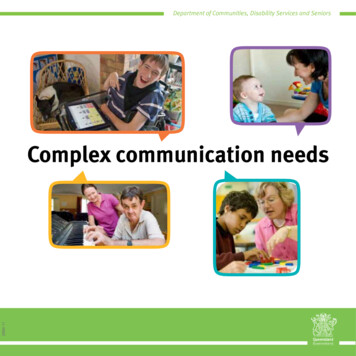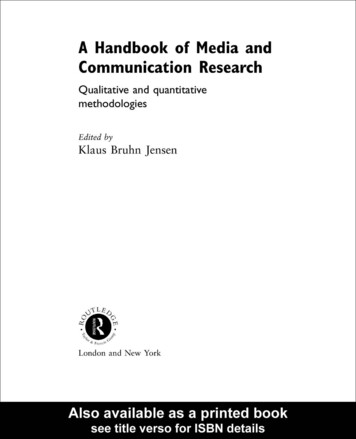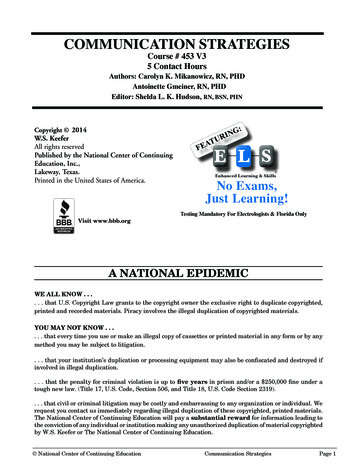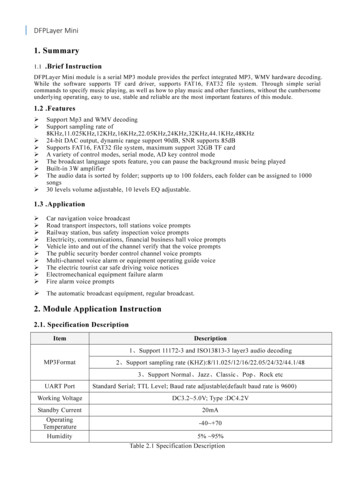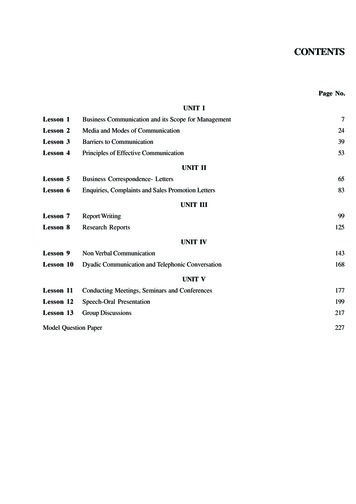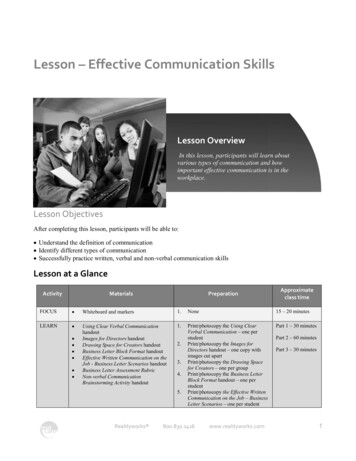
Transcription
1Communicationin health andsocial careUnit outlineCare workers require effective communication skills in order to work with thediverse range of people they meet in health and social care settings. This unitwill introduce you to:different forms of communicationfactors that affect communication in care settingsways of overcoming barriers to effective communication.You will have the opportunity to observe and discuss the communication skillsof others and to practise and refine your own communication skills.Learning outcomes1 Know different forms of communication.2 Understand barriers to effective communication.3 Be able to communicate effectively.Grading guideTo achieve a pass, you must showyou can:P1 Identify different forms ofcommunicationTo achieve a merit, you mustshow you can:To achieve a distinction, you mustshow you can:M1 Describe different forms ofcommunicationP2 Explain barriers to effectivecommunication within a healthand social care environmentP3 Take part in an effectiveone-to-one interactionP4 Take part in an effective groupinteractionM2 Describe the barriers to effectivecommunication in your twointeractionsD1 Assess the strengths andweaknesses of your twointeractions1
Topic 1.1Forms of communicationGetting startedThis topic introduces you to the forms of communication usedby health and social care workers and the contexts in whichthey are used. When you have completed this topic, you should: be able to describe and explain the communication cycle know about one-to-one, group, formal and informalcommunication in health and social care settings be able to describe a range of different forms ofcommunication used by health and social care workers.Key termsDecode: make sense of the information containedin a messageEmpathy: understanding and entering into anotherperson’s feelingsFormal communication: official or correct forms ofcommunicationInformal communication: doesn’t stick to the formalrules of communication (e.g. a casual, relaxedconversation, written note or text message)Makaton: a system of communication using simplehand signs, which is used by people with language andlearning difficultiesNon-verbal communication: forms of communicationthat do not use words (e.g. body language)Objects of reference: objects that have a particularmeaning for a person (e.g. a special ring or ornament)Symbol: an item or image that is used to representsomething elseVerbal communication: forms of communication thatuse words (e.g. conversation)The communication cycleCommunication is about making contact with others and beingunderstood. It involves people sending and receiving ‘messages’.We all communicate, or ‘send messages’, continuously. Figure 1.1describes the communication cycle. It shows that a communicationcycle occurs when:21 IdeaoccursMessagecodedMessage 3sent1. A person has an idea.2. They code their ‘message’ (using words or non-verbal means).3. They send their message to someone else (e.g. by speaking).4. A second person then receives the message (e.g. by hearingwhat has been said or by noticing non-verbal communication).5. The second person decodes the message.6. The message is understood.2Message6 understoodMessagedecoded5MessagereceivedFigure 1.1 The communication cycle4
1 Communication in health and social careOnce the original message has been understood, the cycle will be repeated if thesecond person replies or responds. Repetitions of the communication cycle are anessential part of our relationships, and occur every time we have a conversation.Case studyCharlie is 2 years of age. He enjoys helpinghis mum in the kitchen when she is makinga meal. When she says, ‘Can I get some fruitfor you Charlie?’, he puts his arms in the air,says ‘me, me’ and smiles at her. His mumresponds by picking him up and saying,‘Okay, you take something yourself thistime, Charlie’.1. How does Charlie’s mum communicate withhim in this example?2. How does Charlie communicate non-verballywith his mum in response to her question?3. Describe how a cycle of communicationoccurs in this example.Forms of communicationCare workers use different forms of communication during theirworking day (or night). These include the verbal communication skills oftalking and listening, and various forms of non-verbal communication,such as touch, eye contact and facial expression. A care worker has touse both of these forms of communication when they:give or receive information about the care that is being provided foran individualprovide emotional support to a individual or member of their familycarry out an assessment of an individual’s care needs.Verbal communicationVerbal communication occurs when one person speaks and anotherperson listens. Care workers need a range of verbal communicationskills to:respond to questionsfind out about an individual’s problems or needscontribute to team meetingsbreak bad newsprovide support to othersdeal with problems and complaints.The communication cycle demonstrates that effective verbalcommunication is a two-way process – speaking andlistening must occur. Listening is much harder than speaking andthere is more to this skill than just waiting for the other person tostop talking.Over to you!Are you a good listener? Think aboutwhat you do when you really listento another person. Try to identifythe skills and qualities needed foreffective listening.3
1.1 Forms of communicationNon-verbal communicationAs well as communicating through speech, people use a variety of forms ofnon-verbal communication. Some of these are referred to as body language.This is because they involve the individual using their body and appearance tocommunicate in some way. For example, a care worker’s behaviour, appearanceand attitude send ‘messages’ to people who receive care (as well as to colleagues)about what they think and feel. Similarly, a person’s body language may tell acare worker that they are uncomfortable or experiencing pain even when theysay, ‘I’m okay’. Non-verbal communication is a channel of communication thatis ‘always on’.Figure1.2Forms of non-verbal communicationNon-verbalcommunicationWhat does it involve?ExamplesFacial expressionMovements of the face thatexpress a person’s feelings Smiling FrowningTouch or contactPhysically touching or holdinga person Holding someone’s hand Placing a hand on a person’s arm or shoulder to reassurethemGesturesDeliberate movements of thehands to express meaning Thumbs-up gesture to show agreement or pleasure Shaking a fist to show anger or aggressionProximityThe physical closenessbetween people duringinteractions Being physically close to someone may be reassuring and may beseen as accepting the person. On the other hand, it might make the person feel uncomfortableand threatened. People need less personal space when they have a close, trustingrelationship.Eye contactLooking another persondirectly in the eyes Short or broken eye contact can express nervousness, shynessor mistrust. Long unbroken eye contact can express interest, attractionor hostility.Signs, symbols and objects of referenceCare organisations sometimes use signs and symbols to communicatewith the people who use their premises. Signs and symbols aregraphical ways of communicating essential information. Using imagesenables people who cannot speak or understand a spoken language,such as English, to communicate.Objects of reference are items such as toys, clothes, jewellery orother everyday objects that have a special meaning for somebody. For achild, a cuddly toy may represent comfort and safety. An older personmay treasure their photographs because they represent and providememories of family, friends and relatives. Objects of reference, such asphotos or toys might be used by a teacher to stimulate communicationand interaction with individuals with learning disabilities.4Over to you!When you have a chance, watch agroup of people talking or socialisingtogether. Observe the way they usetheir bodies to communicate. Tryto work out what they are ‘saying’non-verbally.
1 Communication in health and social careTechnological aidsTechnological aids, such as electronic communicators, hearing aids andvideophones are designed to help disabled people who have difficulty sendingor receiving ‘messages’ as part of the communication cycle. Many non-disabledpeople now also use technology in the form of mobile phones, text messagingand emails to communicate with others. Websitessuch as Facebook, Twitter and Bebo are also examplesof technological aids that promote communicationbetween people.Human aidsThese include people who work as:interpreters, who listen to a person speak in onelanguage and then communicate what they havesaid to a second person in a different languagetranslators, who translate what is written in onelanguage into a second language (e.g. English toHindi)signers, who use forms of sign language tocommunicate what has been said or written intoa sign language, such as British Sign Language orMakaton.Alternative forms of communicationPeople who are unable to communicate in conventional ways sometimesuse alternative communication systems to send and receive messages.For example:People with visual impairments often use theirsense of touch to read documents written inBraille. This uses a series of indentations madeby a special stylus on one side of paper. Thecombinations of indentations represent letters thatcan be touch-read by people who understand theBraille system.People with hearing impairments or learningdisabilities sometimes use lip reading andsign language to communicate. Signlanguage systems include finger spelling(dactylography), British Sign Language andMakaton.A range of graphical signs and symbols arealso widely used in health and social care settingsto warn people of health and safety hazards,provide directions and give information to peoplewho are unable to speak or understand English.5
1.1 Forms of communicationContexts of communicationThe two main contexts in which health and social care workers use the communicationcycle are one-to-one and group communication.One-to-one communicationCare workers talk to work colleagues, to people who use care services and to theirrelatives on a one-to-one basis many times each day. Sometimes this involvesformal communication, at other times it involves informal communication,for example when the care worker speaks to a colleague who is also a friend, orwhen they have got to know a patient or relative very well. Effective one-to-onecommunication requires:listening skillsinformation-giving skillsquestioning skills.People who use care services, and their relatives, talk to care workers about awide variety of things that concern them. Care workers need to be able to helppeople talk about and express their concerns. They do this by:using open questions that give people a chance to talk at length rather than togive a one-word response (e.g. ‘How are you feeling today?’ is an open question)checking their understanding of what the person says to them by recapping,summarising or just asking questions like, ‘Can I just check that you meant ’using empathy to let the person know the care worker understands howthey feel and what they think.One-to-one communication skills are needed for basic everyday interactionsin health and social care settings. They are also needed to establish andmaintain supportive relationships with work colleagues and people who usecare services.GroupsPeople belong to a range of different groups including family, friendship andwork groups. Interaction in group situations is important for social, intellectualand emotional development. Health and social care workers communicate ingroup situations when they participate in:report or handover meetings where individuals’ needs are discussedcase conferences and discharge meetingstherapeutic and activity groupsmeetings with relatives and managers of care organisations.The communication skills we use in group contexts are slightly different fromthose we use in one-to-one situations. One of the main differences is that peoplehave to make compromises and must learn how and when to take turns atspeaking and listening. Communication in groups can sometimes feel challenging,competitive and negative where a few members of the group dominate.6ActivityRole-plays provide anopportunity for you todevelop and practise basiccommunication skills in asafe, simulated situation.With a class colleague orin a small group, role-playthe following situation:A parent approaches anursery nurse aboutobtaining a place for hischild at the nursery. Theparent wants to know whatthe nursery can offer, howthe child will be lookedafter and what the costswill be.The nursery nurse mustuse verbal and non-verbalcommunication skills toprovide appropriateinformation and reassurance.
1 Communication in health and social careHowever, groups can also be supportive, cooperative and productive when membersrespect each other, are inclusive and shareinformation. People who are effectivegroup members:make verbal contributions to the grouplisten to other group membersrespond positively to the group leaderare open about themselvesdon’t try to distract others or disruptthe main purpose of the grouphave a positive and constructiveapproach to other group membersarrive on time and stay until the end ofthe group’s meetings.Assessment activity 1.1 (P1, M1)You are working in a local day centre. The peoplewho attend have learning disabilities. The daycentre manager provides work experienceopportunities for local school and college students.She believes that effective communication skills areessential to work in a care environment like the daycentre. The manager has asked you to: Produce training materials that identify anddescribe forms of communication used withina health or care environment. Present your materials in the form of a leaflet,booklet or poster.Topic check1234Describe how the communication cycle works.Name two main forms of communication.What are the two things that people have to do during verbal communication?Describe two ways that care workers might use their verbal communication skills in acare setting.5 Identify three different examples of non-verbal communication.6 Describe how an individual with communication problems might use technological orhuman aids to communicate with others.7 Identify the two main contexts of communication in health and social care settings.7
Topic 1.2Factors affecting communicationGetting startedThis topic provides an introduction to arange of factors that affect communication.When you have completed this topic, youshould: know about a range of factors that canaffect an individual’s ability tocommunicate effectively be able to describe ways of overcomingcommunication barriers.Key termsAcronym: a word formed from the initial letters ofa series of words, such as NHS (National Health Service)Deprivation: the loss or absence of somethingDialect: a form of language spoken in a particular areaBarriers to communicationA number of factors can affect an individual’s abilityto communicate effectively (see Figure 1.3). Thesefactors are sometimes known as barriers tocommunication because they prevent or interferewith the person’s ability to send, receive orunderstand a ‘message’.Sensory deprivation anddisabilityVisual and hearing impairment can act as a barrierto effective communication. Care workers shouldbe alert to the additional communication needsof people with sensory impairments and disabilities.Problems with sight or hearing can mean that signscan’t be seen, leaflets can’t be read or conversationscan’t be heard, for example. Conditions such ascerebral palsy, Down’s syndrome and autism also8Jargon,slang cesLanguagedifferencesEnvironmentalproblemsFigure 1.3 Factors affecting communication
1 Communication in health and social caretend to limit an individual’s ability to communicate verbally and to interpretother people’s non-verbal communication.Foreign language and cultural differencesBritain is a multicultural country.Within the mix of different ethnicgroups people speak a range oflanguages. English may be a second oreven third language for some peopleand may not be spoken orunderstood at all by others. If healthand social care organisations onlyproduce and display information inEnglish and care workers only speakEnglish, some people will find it verydifficult to find and use the careservices they need.Similarly, people from different culturalgroups interpret non-verbal behaviourin different ways and may have adifferent sense of humour. This canlead to ‘messages’ beingmisunderstood by, or making no senseto, the person on the receiving end.ActivityUsing the internet or otherlibrary sources, investigatethe needs of people with oneof the following conditions: visual impairment hearing impairment cerebral palsy Down’s syndrome autism.Start your investigation bygoing to the support groupwebsite for the condition.Produce a leaflet, poster ormagazine story outliningthe communicationproblems experienced bypeople with the conditionyou are investigating.DialectA dialect is a version of a language. People who speak English using aGlaswegian dialect or a Liverpudlian dialect will pronounce the same wordsdifferently and may use some words that are local and specific to the area wherethey live. A person who isn’t from the same area may not understand a local dialect.Distress and emotional difficultiesSome conditions, such as having a stroke, being depressed or having othermental health problems may affect an individual’s ability to communicate,because they affect the person’s ability to send and receive ‘messages’effectively. Similarly, when a person is angry, aggressive or upset, they mayfind it difficult to communicate and their own communication may bemisunderstood by others.Over to you!Think about the last time you were upset or unwell. How did this affectyour ability to communicate? Did other people adapt the way theycommunicated with you or get frustrated and upset themselves?9
1.2 Factors affecting communicationJargon, slang and use of acronymsJargon is technical language that is understood by people in a particular industryor area of work. Health and social care workers often use jargon to communicatewith each other quickly. Slang is an informal type of language that is used by aparticular group of people. Teenagers sometimes communicate with each otherusing forms of slang which their parents and teachers don’t understand.Acronyms are the initial letters of the words in a phrase (e.g. HIV for humanimmunodeficiency virus). Jargon, slang and acronyms all have one thing incommon – they are forms of language that only makes sense to people withspecialist knowledge. A person who doesn’t have this specialist knowledge won’tunderstand a message that includes jargon, slang or acronyms.Over to you!Can you think of any slangterms that are used byyoung people in your localarea? Do you think thatadults or other youngpeople from a different areawould know what theseterms mean?Health issuesIllness and injuries can cause people to withdraw and feel they don’t wish to seeothers or talk about how they are. Medication and operations may also affect anindividual’s ability to speak, concentrate or use non-verbal methods ofcommunicating.Environmental problemsA physical environment that is noisy,uncomfortable, has poor lighting or that lacksprivacy reduces people’s ability to communicateeffectively with each other. Noisy environmentsaffect our ability to listen and concentrate. Poorlighting can affect our ability to notice nonverbal communication and could reduce ahearing-impaired person’s ability to lip read.Environments that are too hot or cold causediscomfort. Environments that lack privacydiscourage people from expressing their feelingsand problems.Over to you!What is the environment at your GP’s surgerylike? Is it quiet, warm and comfortable, or does ithave some of the features described above that10have a negative effect on communication?How could it be improved to promote bettercommunication?
1 Communication in health and social careOvercoming barriers to communicationBarriers to communication can often be overcome, or are at least reduced, by makingchanges to the environment, by changing the way you approach the other person or byusing electronic aids to overcome communication difficulties.Adapting the environmentMaking changes to the physical environment can improvethe effectiveness of communication. Environmentalchanges might include:replacing poor lighting with brighter lightingsound-proofing rooms, reducing background noise orcreating quiet areas away from noisy activityputting up multilingual posters and displayingsigns clearlyfitting electronic devices, such as induction loopsystems to help those with hearing difficulties.ActivityVisit the websites of the Royal National Institute forthe Deaf (www.RNID.org.uk) and the Royal NationalInstitute for the Blind (www.RNIB.org.uk). Findout about the range of services these groups providefor people who have sensory impairments. Producea summary of the different forms of communicationsupport that are available to people with visual orhearing impairments.Care workers can make the best of the care environment by:making sure they can be seen clearly by the person they arecommunicating withfacing both the light and the person at the same timemaking sure their mouth is visible when speakingminimising background noiseusing eyes, facial expressions and gestures to communicate wherenecessary and appropriate.Understanding language needs and preferencesSpecial interest groups work on behalf of people who have sensory impairments orwhose disabilities cause communication problems. These groups provide informationand services that are designed to raise awareness and help people who suffer sensorydeprivation to overcome the barriers to communication they face.Care workers should understand the language needs and communication preferences ofpeople with sensory impairments and disabilities that affect their communication skills.The best way to respond to situations like this is for the care worker to:use the person’s preferred language (directly or through an interpreter or signer)adapt their communication strategies to the language needs and preferences ofthe person.Learning a few words of another person’s language or developing some basic signlanguage skills can really help a care worker to establish a positive relationship with theperson receiving care.11
1.2 Factors affecting communicationPaceSpeaking clearly and slowly, and repeating and rephrasing if necessary, are strategies thatcan help some people to understand what is being said to them. Speaking a little moreslowly can help a person with a hearing or visual impairment, a learning disability or whois confused. The speed or pace of communication may need to be slower to allow theperson to understand what is being said or communicated to them. It is also importantto allow time for the person to respond. This can mean tolerating silences while theperson thinks and works out how to reply.Electronic devicesA range of electronic devices exist to help people overcome the communicationdifficulties they face. These include text phones, telephone amplifiers and hearingloops. Electronic devices can be used both to send and receive messages. It isimportant to give the person using a communication device enough time to useit when you are communicating with them.Reduceoutside noiseListencarefullySpeak clearlyand slowlyAn induction loop system helpsDisplayclear signsWays ofovercoming barriersto communicationAdapt to theperson’s needsUseinterpretersdeaf people hear sounds moreclearly by reducing or cutting outbackground noise.Provideinduction loopsImprove lightingFigure 1.4 Ways of overcoming barriers to communicationCase studyRead the following scenarios. For each ofthem, explain briefly: what are the barriers to effectivecommunication how these barriers could be overcome.1. Salvo is a patient in the medical ward of alarge District General Hospital. His diabeteshas got worse and he has now lost his sight.Salvo finds this very distressing and tends tostay close to his bed for fear of getting lost inthe ward. He is becoming worried that he will12not be able to get to the toilet in time onhis own.2. Edith is 56 years old and has recently suffereda stroke. This has left her paralysed down herright-hand side and she is unable to speak.Edith cannot put her thoughts into words orunderstand words that are written down. Shecan understand some of what is said to her.You have been asked to find out what mealsEdith would like to choose from next week’smenu. You have been given a printed menuthat patients normally fill in themselves.
1 Communication in health and social careAssessment activity 1.2 (P2)The manager of the day centre who asked you toproduce training materials in Topic 1.1 has decided toextend the range of training materials for workplacement students. She has asked you to: Produce training materials that include detailsof a range of barriers in relation to differentforms of communication, explaining ways toovercome these. Present your training materials in the form of aleaflet, booklet or poster.Topic check1 Identify two forms of sensory deprivation that affect a person’s ability to communicate.2 Describe examples of environmental problems that can reduce the effectiveness ofcommunication.3 Explain how care environments can be adapted to overcome the communicationproblems you describe.4 What is a dialect and how can it affect communication?5 Explain why a care worker might adjust the pace of their speech to improve the waythey communicate.6 Describe an example of an electronic device that can be used to overcomecommunication problems.13
Topic 1.3Effective communicationGetting startedThis topic focuses on the skills neededfor effective communication. When youhave completed this topic, you should: know about a range of skills that canbe used to make communication moreeffective be able to demonstrate effectivecommunication skills in one-to-oneand group situations.Key termsEmpathy: putting yourself in the place of the other person and tryingto appreciate how they ‘see’ and experience the worldProximity: physical closenessCommunicating effectivelyEffective communication in care settings helps both care workers andpeople who use care services to form good relationships and to workwell together. People communicate mosteffectively when they:feel relaxedFacialare able to empathise with the otherexpressionpersonexperience warmth and genuineness inthe relationship.Effective communication also requires the careworker to develop and use a range of skills,abilities and communication techniques(see Figure 1.5).Active listeningA person who uses active listening pays closeattention to what the other person is sayingand notices the non-verbal messages they are14AppropriateproximityTone, paceand contentof ivecommunicationresults from ClarifyingmessagesEyecontactEmpathyFigure 1.5 Effective communication results from
1 Communication in health and social careCase studyEileen Morgan has worked in a pre-school nurseryfor the last 15 years. During this time she hasdeveloped very good relationships with thechildren she cares for. Students who come to thenursery on work placement eventually notice thatthe children really like to talk to Eileen. This ispartly because Eileen listens more than she talkswhen she is interacting with a child. Eileen isalways very encouraging when a child comes tospeak to her. She smiles a lot, focuses on theirface, but also notices what they are doing. Shesays this helps her to understand what the childis feeling. She gives each child plenty of time totalk, staying quiet when the child pauses anduses sounds like ‘mm’, ‘uh huh’ and little phraseslike ‘I see’, ‘that’s good’ and ‘tell me more’ toencourage them.1. How is Eileen using active listening skills whenshe interacts with children at the nursery?2. Why does Eileen try to notice what a child isdoing when they are talking to her?3. Give an example of a minimal prompt usedby Eileen to encourage children to expressthemselves.communicating. People who are good at active listening also tend tobe skilled at using minimal prompts. These are things like nods of the head,‘Mm’ sounds and encouraging words like ‘Yes, I see’, or ‘Go on’. Skilful useof minimal prompts encourages the person to keep speaking or to say alittle more.Use of body language and proximityPeople use different forms of body language to communicate feelingsand to support what they are actually saying (see Topic 1.2). Effectivecommunicators often use the SOLER behaviours (see Figure 1.6) whenthey are sitting down talking to another person. These are not hard andfast rules that must always be obeyed but they do encourage moreopen communication.An awareness of proximity, or the amount of personal space that a personrequires, is also an important feature of effective communication. Sittingor standing too close to someone can make them feel uncomfortable andintimidated. Sitting too far away can make the person feel isolated and mightseem unfriendly. Care workers often adjust their proximity by moving theirchair or their position in response to the person’s body language. It can alsobe a good idea to ask, ‘Is it okay if I sit here?’SquarelyAdopt an Open postureLean towards the other personMaintain Eye contactTry to be Relaxed while paying attentionFace the other personFigure 1.6 SOLER behaviours15
1.3 Effective communicationActivityPeople communicate ‘messages’ to others in a variety ofnon-verbal ways. This activity requires you to discreetlyobserve people communicating non-verbally with each other.1. Identify a public place where you can observe
language and then communicate what they have said to a second person in a different language translators, who translate what is written in one language into a second language (e.g. English to Hindi) signers, who use forms of sign language to communicate what has been said or written into a sign language, s

